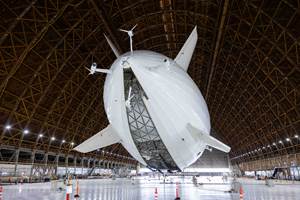Dream Chaser completes free-flight test
Dream Chaser inches closer to first flight in the run-up to servicing the International Space Station, starting in 2020.
Sierra Nevada Corp. (Sparks, NV, US) reported on Nov. 13 that it has completed a successful atmospheric free-flight test of its composites-intensive Dream Chaser spacecraft, signaling the program is another achievement closer to orbital operations.
The full-scale Dream Chaser test vehicle was lifted from a Columbia Helicopters Model 234 UT Chinook helicopter on Saturday, released and flew a preplanned flight path ending with an autonomous landing on Runway 22L at Edwards Air Force Base, CA, US.
“The Dream Chaser flight test demonstrated excellent performance of the spacecraft’s aerodynamic design and the data shows that we are firmly on the path for safe, reliable orbital flight,” says Mark Sirangelo, corporate vice president of SNC’s Space System business area.
The first orbital vehicle is scheduled to go to the International Space Station as soon as 2020 for at least six missions as part of NASA’s Commercial Resupply Services 2 contract (CRS2). The missions will supply astronauts with much-needed supplies and technical support elements and enable the return of scientific experiments. The test vehicle was originally developed under the Commercial Crew Integrated Capabilities agreement (CCiCap).
“The Dream Chaser spacecraft today has proven its atmospheric flight performance along with its return and landing capability. This advances our program and the Dream Chaser towards orbital flight, while meeting the final milestone for our NASA CCiCap agreement and supporting milestone 5 of the CRS2 contract,” Sirangelo adds.
The test verified and validated the performance of the Dream Chaser spacecraft in the final approach and landing phase of flight, modeling a successful return from the space station. Most critically, by flying the same flight path that would be used returning from orbit, this free flight proves the highly important landing attributes needed to bring back science and experiments from the space station.
SNC and NASA will evaluate information from the test, including the Dream Chaser aerodynamic and integrated system performance from 12,400 feet altitude through main landing gear touchdown, nose landing gear touchdown and final rollout to wheelstop on the runway. The Edwards Air Force Base runway is very similar to the Kennedy Space Center Shuttle Landing Facility runway that Dream Chaser will land on for CRS2 flights.
This approach and landing test expands on phase one flight testing, with key differences including adding specific program test inputs into the trajectory, which helps engineers refine the aerodynamic characteristics of the vehicle. Saturday’s test also included orbital vehicle avionics and flight software for the first time, providing orbital vehicle design validation.
“I’m so proud of the Dream Chaser team for their continued excellence. This spacecraft is the future and has the ability to change the way humans interact with space, and I couldn’t be happier with SNC’s dedicated team and the results of the test,” says Fatih Ozmen, CEO of SNC.
The Dream Chaser has been at NASA’s Armstrong Flight Research Center since January undergoing a variety of tests in preparation for the free flight. The spacecraft used the same historic hangar occupied by the Enterprise Shuttle.
Dream Chaser is a reusable, multimission space utility vehicle. It is capable of transportation services to and from low-Earth orbit, where the International Space Station resides, and is the only commercial, liftingbody vehicle capable of a runway landing. The Dream Chaser Cargo System was selected by NASA to provide cargo delivery and disposal services to the space station under the Commercial Resupply Services 2 (CRS2) contract. All Dream Chaser CRS2 cargo missions are planned to land at Kennedy Space Center’s Shuttle Landing Facility.
Related Content
Combining multifunctional thermoplastic composites, additive manufacturing for next-gen airframe structures
The DOMMINIO project combines AFP with 3D printed gyroid cores, embedded SHM sensors and smart materials for induction-driven disassembly of parts at end of life.
Read MoreManufacturing the MFFD thermoplastic composite fuselage
Demonstrator’s upper, lower shells and assembly prove materials and new processes for lighter, cheaper and more sustainable high-rate future aircraft.
Read MoreCryo-compressed hydrogen, the best solution for storage and refueling stations?
Cryomotive’s CRYOGAS solution claims the highest storage density, lowest refueling cost and widest operating range without H2 losses while using one-fifth the carbon fiber required in compressed gas tanks.
Read MoreNext-generation airship design enabled by modern composites
LTA Research’s proof-of-concept Pathfinder 1 modernizes a fully rigid airship design with a largely carbon fiber composite frame. R&D has already begun on higher volume, more automated manufacturing for the future.
Read MoreRead Next
Plant tour: Daher Shap’in TechCenter and composites production plant, Saint-Aignan-de-Grandlieu, France
Co-located R&D and production advance OOA thermosets, thermoplastics, welding, recycling and digital technologies for faster processing and certification of lighter, more sustainable composites.
Read MoreAll-recycled, needle-punched nonwoven CFRP slashes carbon footprint of Formula 2 seat
Dallara and Tenowo collaborate to produce a race-ready Formula 2 seat using recycled carbon fiber, reducing CO2 emissions by 97.5% compared to virgin materials.
Read MoreVIDEO: High-volume processing for fiberglass components
Cannon Ergos, a company specializing in high-ton presses and equipment for composites fabrication and plastics processing, displayed automotive and industrial components at CAMX 2024.
Read More

























